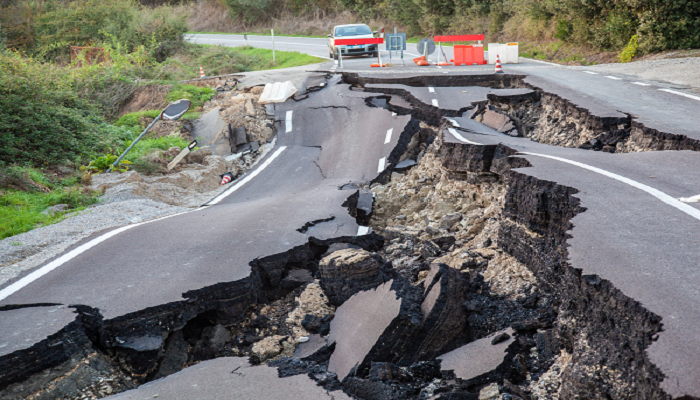The Ghana Geological Survey Authority (GGSA) has warned of an imminent earthquake in the country following the tremors that have been occurring in recent times.
According to the GGSA, signs picked up after earth tremors hit parts of Accra on March 24, 2018 showed that the fault lines were active, “which means that an earthquake can occur at anytime.”
A senior seismologist at the GGSA, Mr Nicholas Opoku, who spoke with the Daily Graphic on Tuesday, confirmed that there was seismological disturbance in the Weija area in the south-western part of Accra last Saturday.
Mr Opoku said the time transmission reading on the seismometer at the authority’s remote station near the Weija Dam indicated that three tremors occurred on the same day, with the first two happening at 3:09 a.m. and 3:41 a.m., while the third one took place at 11:31 a.m. last Saturday.
“It is clear — the evidence is that an earthquake occurred,” he stated.
He, however, said readings had to be done at two other stations at Akuse and Akosombo to ascertain the magnitude of the tremor because there was currently a challenge with the transmission of signals.
Mr Opoku said data from the seismometers were normally transmitted near real time to the central observatory at the Achimota Forest in Accra at a go but they had to resort to stand-alone monitoring (personal visits) at the stations because of the challenge with data transmission.
He explained that but for the challenge, the transmission of data from multiple stations could have been done through satellite with a 3G modem.
Epicentre
Mr Opoku said it could not be determined yet where the epicentre of the tremor was because the GGSA had only the record from one station at the time he spoke with the Daily Graphic.
“We are not sure whether the tremor was even offshore or inland,” he said, adding that it was almost certain to be around the McCarthy Hill, Weija and Nyanyano enclave.
Looming earthquake
Responding to whether the tremors signified a looming earthquake in the country, Mr Opoku said: “An earthquake has a return period, so once we have had a major earthquake like 6.5 on the Richter scale in Accra in 1862 and 1939, it can come and it can even be bigger than that.”
According to earthquaketrack.com, although Ghana’s severest earthquake yet was experienced 79 years ago on June 22, 1939, with a magnitude of 6.4 on the Richter scale, there had been a series of earthquakes (some refer to them as tremors) in more recent times.
The fast-sprawling town of Kasoa in the Central Region and Gbawe in the Greater Accra Region have shared the most spoils in occurrence.
The most recent, with a 5.9 magnitude and a 33-kilometre depth, occurred at 3 p.m. on September 26, 2007, 11 years ago, 385.2 kilometres from Takoradi, while 21 years ago at 3:16 p.m. on March 6, 1997, another one measuring 4.4 in magnitude and with a depth of 10 kilometres occurred 6.2 kilometres from Gbawe.
Gbawe was in the news again 28 years ago with two earthquake experiences. The first, measuring 3.1 in magnitude and 10 kilometres in depth, occurred at 11:43 a.m. on April 14, 1990. 4.2 kilometres from the town, while the second, which measured 2.7 in magnitude and 10 kilometres in depth, occurred at 1:34 a.m. on February 12, 1990, 1.2 kilometres from the community.
In the last 31 years, Kasoa has also had its fair share of earthquakes — there was one measuring 2.0 in magnitude on March 23, 1989; 3.4 in magnitude on February 27, 1988 and 3.1 in magnitude on December 3, 1987, all 10 kilometres in depth.
Bigger earthquake
On whether or not Ghana could experience a bigger earthquake than it did in 1939, Mr Opoku said what was lacking was that “we have not done period seismological studies.”
According to him, the highest magnitude of 6.5 recorded in 1939 was an estimate and was not recorded with instruments which were non-existent at the time but was based on the intensity of the quake, how buildings collapsed and how people felt it.
“It could even be bigger than the 6.5 as recorded in 1862 and 1939 so all the small incidents that are occurring are evidence that the fault is active. If the fault is not active, it cannot give out an earthquake.
“If a fault is active, it gives out earthquake, so it means that our fault zones are still active and it is possible that they can give a bigger event in future,” he stated.
Mr Opoku said mountainous regions in earthquake-prone zones in the country “are not areas people should venture to put up structures.”
He mentioned the Akwapim Range as a fault zone where earthquakes could also occur, saying that due to tectonic activities, the rocks there were even deformed and “so with a little shaking, the entire rock can undergo a landslide or rockslide.”
Seismic assessment
Mr Opoku said Ghana would host an international workshop on seismic hazard assessment this year, saying the about 26 participants from Africa would learn how to do seismic hazard assessment.
He explained that there was now the need to give a projection of the probability of the occurrence of earthquakes, which would inform the steps to be taken to minimise any disasters or casualties that might occur in the event of earthquakes.
Source: Graphic.com.gh














